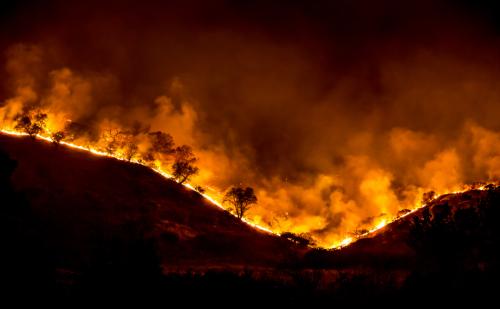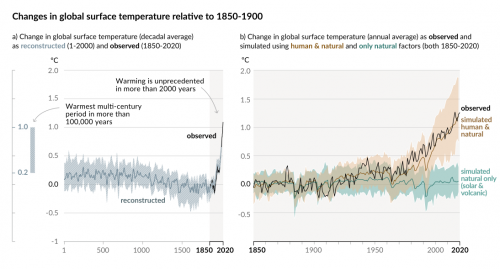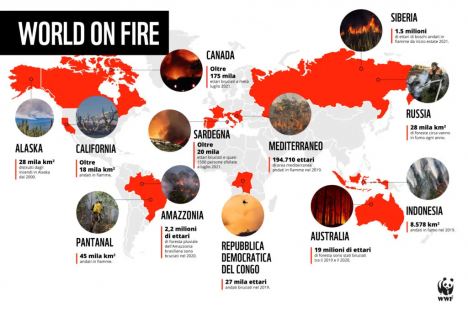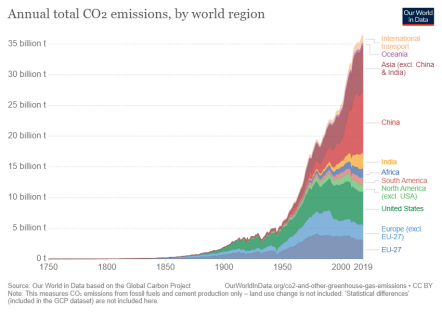Summary
The sixth IPCC report on climate change states that man-made greenhouse gas emissions are the cause of: rising temperatures, melting ice caps, and rising sea levels. The massive increase in emissions of greenhouse gases coincides with the existence of the capitalist mode of production and have intensified with its present structural crisis. Capitalism is the cause of climate change. The scale of recent changes is in many ways unprecedented. Production and consumption of fossil fuels are an integral part of the capitalist production system. A substantial abandonment of fossil fuels thus appears unlikely. The main consequences of climate change are the worsening of living conditions for hundreds of millions of human beings and the intensification of migration. A change of historical significance is required, one that is capable of modifying, or rather, ending the relationship between capitalist production and the environment. Only an internationalist proletarian revolution can constructively bring about a new relationship between humanity, production and the environment, by following the evidence that science gives us – something that cannot happen today because it clashes with the pursuit of profit. This is the perspective the internationalists are fighting for within the world working class.
The Report
To crown a summer of record temperatures, the first part of the IPCC's sixth climate report arrived on 7 August. In it, scientists from the inter-governmental body which monitors climate change describe the changes taking place. In 2022, two more reports will follow. The first will be on the impact, changes and vulnerabilities brought about by climate change, the second on possible methods to mitigate climate change. The report’s conclusions represent the more or less unanimous view of world climatologists on the subject. Among climatologists, deniers of human-made climate change make up less than 0.01% (Powell, 2019).
Here, we will follow the results of the Summary for Policymakers (IPCC, 2021) indicating in brackets the chapter to which we refer and interspersing the reading of the report with our own comments.
The Current State of the Climate
The Report:
It is undeniable that human activity is the cause of the current warming of the atmosphere, oceans and land. This warming is the cause of widespread and rapid changes in the atmosphere, oceans, cryosphere and biosphere.
p.5
Increases in the concentration of greenhouse gases in the atmosphere (in particular CO2, CH4 and N2O) are detectable from 1750 and are undeniably due to human activity. Starting in the mid-1970s, the situation then began to deteriorate:
each of the last four decades has been hotter than the previous ones.
ibid.
Another source describes the same data even better: there has been an increase of 1.1°C since the end of the 19th century but:
two-thirds of this increase ha occurred since 1975, when the rate of increase began to grow by 0.15-0.20°C every decade.
Tozzi, 2020, p.54
This human activity has been the main vector of the global retreat of glaciers since the 1990s; the decrease in Arctic ice recorded since 1979; the reduction of spring snows in the northern hemisphere; the melting of the Greenland icecap(1) and the ongoing shift of climatic belts towards the poles of both hemispheres. The same human activity has caused: a reduction of oxygen in the oceans since the 1950s, the rise in their temperature since the 1970s and their current acidification.
Since 1900 the sea level has risen by 20 centimetres. With the following historical trend:
- (1901-1971) + 1.3mm / year;
- (1971-2006) + 1.9mm / year;
- (2006-2018) + 3.7mm / year.
Until the 1970s the planet was successful in absorbing a good part of the greenhouse gases produced by human activity but after that the “equilibrium” was broken.
Reflection 1: The report speaks of generic influence or "human" activity, but we believe it makes sense to reflect on the fact that humans, homo sapiens, have been on planet Earth for almost 300 thousand years, while the phenomena described concern only the last 250 years, with an increasing peak in the last 50 (see Graph 1). Evidence shows that it is not generic "human activity" that causes current climate change, but the specific form that this activity has taken in the last quarter of a millennium: i.e. the capitalist mode of production. The massive emissions of greenhouse gases that affect climate change coincide with the spread of capitalist industrial society, starting from the mid-eighteenth century, and have intensified as capitalism has become the undisputed mode of production on the entire planet.
Reflection 2: The situation of global warming has got progressively worse since the 1970s. This coincides with the opening of the structural crisis of the third cycle of capitalist accumulation, in which we still live today (Damen, 2020). There is plenty of data to show how the counter-trends that capital has put in place to postpone and limit the effects of its economic crisis have had a devastating impact on the climate and environment, leading to a massive increase in greenhouse gas emissions. (Graph 3). We recall, among the main counter-trends, the following: the microprocessor revolution, the shift of production to the countries of the capitalist periphery, the birth of new commodity sectors, the increase in the mass of goods produced together with the increase in their speed of circulation and the reduction of production costs, starting with wages.
The Report: (A.2) The scale of recent changes in the climate system is, in many respects, unprecedented and unknown to mankind: CO2 concentrations in the atmosphere, and the acidity levels of the current oceans are unprecedented in the last 2 million years; to find today's concentrations of CH4 and N2O, it is necessary to go back at least 800,000 years; to find such a sudden rise in atmospheric temperatures 125,000 years; and for sea temperatures we have to go back 11,000 years, to the end of the last ice age.
Reflection 3: In the face of such data, A. Guterres, UN Secretary General judged that:
This report must sound the death knell for coal and fossil fuels before they destroy the planet.
And here is the point. The entire third cycle of capital accumulation (1945- ...) was based on these fuels as the main energy source. In line with historical materialism, a structural revolution of the primary energy sources used by the system is highly unlikely without the planet going through a radical social, economic and political change in terms of the organisation of production. A structural change of this magnitude could only occur as a result of an event of historical significance such as: a generalised war, the global collapse of capitalist civilisation or an international revolution.
The current global capitalist order has literally built and defined itself, in its present form, around fossil fuels. Let's take some examples. The top 10 oil and gas companies (most of them public) produce 22% of greenhouse gases alone (Fontana, 2019), the 100 global companies that deal with fossil fuel are responsible for over 70% of emissions (Griffin, 2017). The oil industries are economically among the most important on the planet, 6 of them are among the 11 companies with the highest profits ever, and in the last decade global oil consumption has continued to grow steadily (Sonnichsen, 2021); fossil fuels are involved in the production of the vast quantity of goods traded worldwide; oil companies still continue to invest huge amounts of new capital in their extraction, refining and distribution activities, and the consumption of fossil fuels has continued its unstoppable progress since the beginning of the industrial era (Graph 2 shows the trend of this consumption in the last 50 years).
The Report: (A.3) Climate change activates three types of extreme climatic and meteorological events in different areas of the planet:
- extreme heat and heat waves;
- massive rainfall and increasingly powerful tropical cyclones;
- drought.
And in addition there are the effects of rising sea levels: the melting rate of the ice sheets alone increased fourfold between the 1990s and the 2010s (A.4). The consequences of these events tend to be more and more frequent and intense: floods, famines, fires and desertification.
Reflection 4: Desertification is advancing unstoppably in sub-Saharan Africa, in southern Australia, increasingly affecting the countries of North Africa; rising seas flood the densely populated plains of areas such as Pakistan and Bangladesh, eve threatening new islands and territories; tropical cyclones of ever greater size and power are bringing entire populations to their knees; persistent drought afflicts entire states of central Africa producing deadly famines: mass migrations are one of the most visible direct consequences of such climate change (Tozzi, 2020). Due to prolonged drought, Lake Urmia in Iran, once the largest in the Middle East, has halved since the 1990s and today is in danger of disappearing, leaving an expanse of salt. Water supply is becoming an increasingly serious problem across the Middle East, with extreme peaks in Jordan (Pleingen et al, 2021) where the drying up of the Jordan River is also contributing to the disappearance of the Dead Sea, just as it once did to the Aral Sea and Lake Chad. The first water riots are taking place in Iran (ICT, 2021). On Saturday 14 August 2021, for the first time since the surveys began in the 1950s, precipitation on the peaks of Greenland was rain instead of snow (Ramirez, 2021). Massive fires, the offspring of drought, follow one another in the Amazon, Angola, Australia, Congo, Siberia, the USA ...
Capitalism is based on the intensive and extensive exploitation of human beings(2) as planetary resources. The climate emergency, with its consequences for the population of the planet, adds to the suffering already inflicted on the world population by imperialist wars and economic crises. All three of these factors, which characterise our era and influence and feed each other, are determined by the same common denominator: the capitalist mode of production and its structural crisis that began in the early 1970s.
Possible Climatic Futures
The Report: (B.1) The identifiable causes of climate change are essentially three: greenhouse gases, land use and air pollution. The IPCC offers some possible future scenarios depending on how these three variables could be reduced, kept stable or increase their impact on the atmosphere in the short (2021-2040), medium (2041-2060) and long (2081-2100) term.
In the presence of an immediate and drastic reduction in greenhouse gas emissions, with a "zero emissions" target by 2050, the temperature (currently at +1.1°C) would rise to +1.5°C in the short term, to + 1.6°C in the medium, to begin to drop to +1.4°C in the long term, but we would have to change the mode of production now.
In the intermediate scenario of a progressive reduction in the increase of emissions, to reach "zero emissions" by 2070, there would be an increase to +1.5°C in the short term, to +2°C in the medium, to +2.7°C in the long term, the effects on humanity would be very severe and will be described in the next report. In the intermediate scenario of a more or less constant rate of emissions to about 2060 and thereafter a reduction to about a quarter of the present level by 2100, there would be an increase to +1.5°C in the short term, to +2°C in the medium, to +2.7°C in the long term, the effects on humanity would be very severe and will also be described in the next report.
In the scenario of a predictable – in our opinion – maintenance of the current greenhouse gas emission trend (scenario 4 out of 5 among those foreseen by the IPCC), it would reach +1.5°C in the short term, +2.1°C in the short term. medium and +3.6°C in the long term. By comparison, the last time the global temperature reached or exceeded +2.5°C was 3 million years ago. However, emissions could even increase and/or the climate could react unexpectedly, and this could lead to even worse scenarios.
In prospect, all the extreme climatic events described above will intensify as a function of the increase in temperatures, while the CO2 absorption capacity of oceans and lands will become proportionately less and less efficient in slowing the accumulation of CO2 in the atmosphere. Many changes triggered by past and present greenhouse gas emissions are already irreversible today for a period ranging from hundreds to thousands of years. The sea level – compared to 2014 – will rise by 2100 by a variable measure between +28cm and +101cm depending on the scenario, to reach a value that can fluctuate between + 37cm and + 2m or more by 2150. It all depends on how quickly greenhouse gas emissions will be reduced and on the possible unpredictable effects of an intensification of the melting of glaciers.
Reflection 5: The question is: how will it be possible to achieve the desired and necessary reduction of greenhouse gases? Based on the data currently available to us, their drastic and immediate reduction appears at least unlikely at the moment. In old capitalist countries, such as Europe and to a lesser extent the USA, a certain reduction is underway, together with a timid increase in CDR (Carbon Dioxide Removal) technologies, including the planting of new trees – it is estimated that at least 1,200 billion should be planted (Tozzi, 2020). Reformism – new and old – affirms that it is time for states, if not the central banks, to finance ecologically compatible production in favour of the so-called green transition (Roberts, 2021). Is the system as a whole therefore acknowledging the need to reduce greenhouse gases? Reality speaks otherwise. Jay Powell, governor general of the US Federal Reserve, stated on June 4, 2021 that:
Today, climate change is not something we consider directly in the definition of monetary policy.
And in fact, observing Graph 3 we see how in the productive heart of contemporary capitalism – Asia, and in particular the emerging imperialist powers, China and India, where the production of goods has been transferred to most since the early 1970s – the levels of CO2 production have increased dramatically, abundantly offsetting the timid reductions found in areas of “old” capitalism, such as Europe, which today tends to be devoted to assembly and high-tech production, and the USA, the leading global imperialist power, but today in apparent decline (FD, 2021). Here CO2 emissions remain basically the same.
From the facts above it emerges that the current framework needs to be profoundly shaken up, and at a structural level, to avoid the worst consequences of the aggravation of climate change described above. It is difficult to predict the real impact of these extreme climatic consequences on the social, health, economic and war levels worldwide and, perhaps, they will themselves cause mass mobilisations capable of triggering future radical change.
We do not believe it plausible that political choices such as those that might be made at the next November Climate Conference in Glasgow – yet another – will represent any more than good intentions that can be ignored.
We repeat: the problem is systemic and structurally intrinsic to capitalism itself, so that only a historical change such as a world war, the general collapse of the system or an international proletarian revolution could lead to profound modification or demolition of the capital-production-environment relationship.
Although a generalised war – or the barbaric collapse of the system – could affect the substantial reduction of greenhouse gas emissions, only a new social organisation, the product of a proletarian and anti-capitalist political revolution, could intervene according to a rational and constructive plan to:
- manage the dramatic consequences in human terms dictated by the irreversible climatic upheavals already activated in different latitudes;
- launch new production methods that provide for a net reduction in CO2 emissions, full respect for the environment, for the human being, and the application of what the scientific world is telling us. In fact, the search for profit as the prime mover of economic and social development is the main obstacle to achieving a harmonious relationship between human beings and the environment, as even bourgeois science suggests.
From the point of view of those of the working class who grasp this already, it is therefore a question of combining the denunciation of the effects of global warming with the battle against capitalism as a whole. In order to pursue this ambitious project, internationalists undertake to produce and circulate a critique of capitalism on the three levels of the environment, imperialism, and the economy. The climate question, as we have seen, is also a product of the relationship between classes: between a predatory bourgeoisie that strips the planet of all its resources, and a proletariat that must find within itself, starting from its most advanced part, the ability to combine the fight against exploitation, war and climate change and environmental devastation with the strategic elements of a revolutionary project.
Starting from these minimum guidelines, a discourse on climate change in terms of revolutionary change can and must be developed.
Loto
Bibliography:
- Climatizzati. (2019). Petrolio? Business as usual ... anzi peggio: crescita del 12% entro il 2030. climatizzati.ch
- Carbon Dioxide Removal. en.wikipedia.org
- edition.cnn.com
- Damen, F. (2020). Il capitalismo è crisi. Milano: Edizioni Prometeo
- FD. (2021). 15 August 2021. leftcom.org
- Fontana, C. (2019). 20 multinazionali del petrolio e gas producono da sole il 30% delle emissioni. 7 January 2019, valori.it
- Griffin, P. (2017). The Carbon Major Database. CDP report, July 2017
- ICT. (2021). Iran: On Oil and Troubled Water. leftcom.org
- IPCC ipcc.ch
- Pleitgen, F., Otto, C., Dewan, A., Tawfeeq, M. (2021) The Middle East is running out of water, and parts of it are becoming uninhabitable. 22 August 2021. edition.cnn.com
- Roberts, M. (2021).Climate change: the fault of humanity? thenextrecession.wordpress.com
- Our world in data. ourworldindata.org
- Powell, J. L. en.wikipedia.org
- Ramirez, R., (2021). Rain fell at the normally snowy summit of Greenland for the first time on record. 19 August 2021. edition.cnn.com
- Sonnichsen, N. (2021). Global Oil Industry, Statistics & facts. statista.com
- Tozzi, M., Baglioni, L. (2020). Un’ora e mezzo per salvare il mondo. Roma: Rai Libri
Notes
(1) On 1 August 2019, documentary film maker Caspar Haarloev filmed the rivers of melted ice formed on the Greenland polar ice cap. It is estimated that 11 billion tons of ice melted in Greenland alone on 31 July 2019 (Tozzi, 2020).
(2) For human beings, the intensive exploitation of labour power is called relative surplus value, the extensive, absolute surplus value.



















